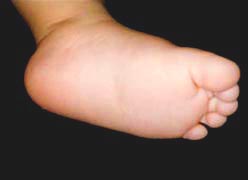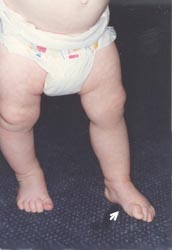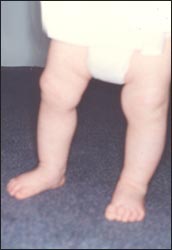편평족(편평발/평발), Flatfoot

사진 76. 대부분의 영유아들의 발바닥은 정상적으로 편평하다. 평발이 있는 것 같이 보이지만 점점 더 성장하면서 발 바닥 아치가 점차로 뚜렷하게 나타나는 것이 정상이다.
Copyright ⓒ 2011 John Sangwon Lee, M.D., FAAP

사진 77. 대부분의 영유아들의 발은 평발 같이 보이지만 성장하면서 아치가 점차로 뚜렷하게 나타나는 것이 정상이다.
Copyright ⓒ 2011 John Sangwon Lee, M.D., FAAP

사진 78. 생후 9개월 된 영아가 서 있는데도 발바닥 아치(→)가 정상적으로 나 있는 것을 볼 수 있다.
Copyright ⓒ 2011 John Sangwon Lee, M.D., FAAP

사진 79. 생후 10개월 된 영아가 서 있는데도 발바닥 아치가 정상적으로 나 있는 것을 볼 수 있다.
Copyright ⓒ 2011 John Sangwon Lee, M.D., FAAP

사진 80. 발을 바닥에서 들어 올리고 발에 힘을 주지 않을 때는 그 발바닥에 아치가 정상적으로 생겨 있는 것을 볼 수 있다. 그러나 발을 바닥에 대고 그 발에 체중을 가하고 힘을 주고 서면 발바닥 아치가 없는 평발과 비슷하게 힘을 받아 편평하게 된다. 발목과 발의 인대, 건이나 근육 등이 연약한 발로 힘을 주고 설 때 아치가 없는 평발 같이 발바닥이 편평하게 될 수 있다. 이런 평발을 생리적 평발이라고 한다.
Copyright ⓒ 2011 John Sangwon Lee, M.D., FAAP

사진 81. 발목 근육이나 인대 등이 선천적으로 미약한 영유아들의 발에도 아치가 정상적으로 있지만 그 발로 힘을 주고 설 때는 발의 아치가 없는 것같이 보이고 발바닥이 편평하게 보일 수 있다. 발 사진에서 보는 것 같이 그 발을 바닥에서 위로 들어 올릴 때 원래 있던 발의 아치가 나타난다. 이런 평발을 생리적 평발이라고 한다.
Copyright ⓒ 2011 John Sangwon Lee, M.D., FAAP

사진 82. 척수 종양으로 생긴 비정상적 발바닥 아치(발궁)
이 아이는 소아 건강검진을 받으러 소아청소년과에 왔을 때 발바닥에 비정상적으로 상당히 높은 아치가 있었다. 검진을 받은 후 척수 종양을 진단받았다.
Copyright ⓒ 2011 John Sangwon Lee, M.D., FAAP

사진 83. 척수 종양으로 생긴 비정상 발바닥 아치
이 아이는 소아 건강검진을 받을 때 발바닥 아치가 비정상적으로 높다고 진단 받은 후 척수 종양을 확진 받았다.
Copyright ⓒ 2011 John Sangwon Lee, M.D., FAAP
편평족(편평발/평발)의 원인
- 발 아치가 조금도 없는 발을 편평족, 평발, 또는 편평발이라고 한다.
- 대부분의 신생아들, 영유아들이나 학령기 전 유아들의 발바닥은 정상적으로 편평하거나 발에 아치가 조금 생겨 잇는 것이 보통이다.
- 발에 기질적 문제가 없이 생리적으로 생긴 이런 편평족 또는 평발을 생리적 편평족이라 한다.
- 발바닥에 정상적으로 아치가 있는 영유아들과 사춘기 이전 학령기 아이들이 두 발에 전 체중을 지탱하면서 서 있을 때 발바닥 아치가 조금도 없는 것 같이 발바닥이 편평해지고, 발이 편평하게 보일 때가 많다. 발목뼈나 발 뼈에 어떤 이상이 있을 때
- 발이나 발목의 인대, 건 등이 선천성으로 미약하거나 늘어질 때,
- 발목이나 발의 근육에 이상이 있을 때,
- 발목이나 발의 신경이 마비됐을 때는 아치가 없는 편평족이 생길 수 있고,
- 때로는 비정상적으로 아치가 더 크게 생길 수 있다.
- 척수 종양으로 발 아치가 비정상적으로 크게 생길 수 있다.
편평족(편평발/평발)의 증상 징후
- 1∼4세 유아를 소아청소년과에 데리고 와서 “발이 편평족(평발)인지 진찰해 달라”고 하는 부모들도 있다. 갓 태어나서부터 유치원에 입학할 때까지 대부분의 신생아들, 영유아들이 누워 있을 때, 또는 앉아 있을 때는 그들의 대분분의 발바닥에 아치가 있는 것을 볼 수 있다.
- 맨 발로 서있는 동안 있는 아치가 없어지고 발바닥이 편평해지는 것이 보통이다.
- 그러나 같은 영유아들이 발을 바닥에서 떼어 들고 서 있는 동안은 발바닥에 아치가 정상적으로 뚜렷하게 다시 나타나서 발바닥이 편평하게 보이지 않는다. 즉 발 아치가 있는 것을 볼 수 있다.
- 발바닥에 아치가 있는 건강한 영유아들이 바닥을 딛고 서 있는 동안은 발에 아치가 거의 없어지는 것이 정상이다.
- 이런 편평족을 생리적 편평족 또는 생리적 평발이라고 한다.
- 영유아들의 발의 근육, 인대, 건은 정상적으로 연약하고,
- 영유아들은 많이 서고 걸을 필요가 없고
- 조금밖에 걷지 않고,
- 또 발바닥에 살이 통통히 많이 쪄있기 때문에 발바닥에 아치가 전혀 없는 것같이 보이기도 한다.
- 또 아치가 뚜렷이 있는 발바닥으로 체중 전체를 지탱하면서 디디고 서 있는 동안 아치가 일시적으로 없어지는 것도 정상이다.
- 점점 더 자라서 많이 걸어야 할 때가 되면 영유아기에 편평하게 보이던 발바닥에 아치가 자연적으로 뚜렷하게 크게 생기는 것이 정상 성장 발육이다.
- 이런 편평족도 생리적 편평족에 속한다.
- 1~4세 유아들에게 생리적으로 생긴 편평족을 신발로 치료해서는 안 된다.
- 발 아치를 크게 만들어 주기 위해 신발의 안쪽 바닥에 패드를 대는 치료를 할 필요가 없다.
- 4~5세 정도 되면 많이 걷고 달리고 그 외 다른 육체적 운동을 많이 하기 때문에 생리적 편평족이 있는 발바닥에 아치가 뚜렷하게 정상적으로 생기게 된다.
- 아이들의 키가 서로 다른 것과 같이 아이들의 발의 아치의 크기도 제각기 조금씩 정상적으로 다르다.
- 4~5세 이후 유아들이나 학령기 아이들 7명 중 1명 정도는 발에 아치가 거의 없고 발바닥이 편평할 수 있다.
- 이것도 거의가 정상적이다.
편평족(편평발/평발)의 진단
- 병력·증상 징후·진찰소견 등을 종합해서 편평족을 진단한다.
- 드물게 발 X선 사진 검사로 진단한다.
- 발에 정상적으로 아치가 있지만 걷거나 서 있을 때 발 아치가 아주 없는 것같이 발바닥이 편평하게 보일 때가 많다.
- 그런 유아들이나 학령기 아이들이 발의 앞부분과 발가락으로 딛고 서 있는 동안이나 그 발을 바닥 위에서 떼어 들고 있는 동안에는 그 발에 아치가 정상적으로 뚜렷하게 생겨있는 것을 보고 아치가 있는 발인지 없는 발인지 진단할 수 있다.
- 그렇지만 발을 바닥 위로 들고 있을 때 아치가 뚜렷하게 나타나 있던 발을 다시 바닥을 디디고 서면 발바닥이 또다시 편평하게 펴지고, 발 아치가 거의 없어져서 그 발이 편평족 같이 보이는 것이 보통이다.
편평족(편평발/평발)의 치료
- 어리고 연약해서 영유아들의 발바닥이 정상적으로 편평하게 보이는 생리적 편평족은 아무런 치료가 필요 없다.
- 비정상적으로 생긴 병적 편평족은 신발 안쪽 바닥에 쿠션 등을 넣어 치료해 줄 수 있지만, 그런 치료의 효과는 확실치 않다.
- 편평족으로 많이 걷거나 운동을 많이 하면 발이나 발목이 많이 아플 때, 발바닥이 비정상으로 뻣뻣할 때는 원인을 찾고 원인에 따라 적절히 치료한다.
- 사실은 이런 치료를 받아야 하는 편평족은 아주 드물다.
- 그렇지만 발 아치가 지나치게 높을 때는 의사의 진단 치료를 꼭 받아야 한다.
- (사진 82, 83 참조)
- 대부분의 편평족은 정상적으로 생기는 생리적 편평족이다.
- 사진 82와 83에서 생후 4세까지는 정상적으로 발바닥에 아치가 있었다.
- 그 후 발바닥 아치가 아주 심해 생겼던 예이다.
- 자세한 검진과 검사에서 척수 종양을 진단했다.
Flatfoot

Flatfoot Picture 76. The soles of most infants and young children are normally flat. It is normal for the arch of the foot to appear progressively distinct as it grows older, although it appears to have flat feet. Copyright ⓒ 2011 John Sangwon Lee, M.D., FAAP

Photo 77. Most infants’ feet look like flat feet, but it is normal for the arch to become more distinct as they grow older. Copyright ⓒ 2011 John Sangwon Lee, M.D., FAAP

Photo 78. It can be seen that the plantar arch (→) is normally extended even when a 9-month-old infant is standing. Copyright ⓒ 2011 John Sangwon Lee, M.D., FAAP

Photo 79. It can be seen that the plantar arch is normally extended even when a 10-month-old infant is standing. Copyright ⓒ 2011 John Sangwon Lee, M.D., FAAP

Picture 80. When the foot is lifted off the floor and no force is applied to the foot, it can be seen that the arch is normally formed on the sole of the foot. However, if you put your foot on the floor and put your weight on the foot and apply force to it, it will receive force and become flat, similar to a flat foot without a plantar arch. When the ligaments, tendons or muscles of the ankle and foot give strength to the weak foot and stand, the sole of the foot may become flat, like a flat foot without an arch. Such flat feet are called physiological flat feet. Copyright ⓒ 2011 John Sangwon Lee, M.D., FAAP

Photo 81. Even though the feet of infants and young children with congenitally weak ankle muscles or ligaments have normal arches, when they stand with their feet, it looks like there is no arch and the soles of the feet may look flat. As you can see in the foot photo, the arch of the original foot appears when the foot is lifted up from the floor. Such flat feet are called physiological flat feet. Copyright ⓒ 2011 John Sangwon Lee, M.D., FAAP

Picture 82. Abnormal plantar arch (foot arch) caused by a spinal cord tumor When this child came to the Department of Pediatrics for a pediatric health check-up, there was an abnormally high arch on the sole of the foot. After examination, he was diagnosed with a spinal cord tumor. Copyright ⓒ 2011 John Sangwon Lee, M.D., FAAP

Picture 83. Abnormal plantar arch caused by a spinal cord tumor This child was diagnosed with a spinal cord tumor after being diagnosed as having an abnormally high plantar arch during a pediatric health checkup. Copyright ⓒ 2011 John Sangwon Lee, M.D., FAAP
Causes of flatfoot
• A foot without any arch of the foot is called flatfoot, flatfoot, or flatfoot.
• Most newborns, infants, and preschoolers have normally flat soles or slightly arched feet.
• Physiological flatfoot or flatfoot that occurs physiologically without any organic problem in the foot is called physiological flatfoot.
• When infants and toddlers and pre-pubertal school-age children who have normal arches on their soles stand while supporting their entire weight on both feet, the soles of the feet are often flat, as if there were no arches at all, and the feet often look flat. When there is something wrong with the ankle or foot bones
• When the ligaments or tendons of the foot or ankle are congenitally weak or sagging,
• When there is a problem with the muscles of the ankle or foot,
• When the nerves in the ankle or foot are paralyzed, flat feet without arches can occur.
• Sometimes the arch can be abnormally large.
• A tumor in the spinal cord can cause an abnormally large arch of the foot.
Signs. symptoms of flatfoot
• Some parents bring their 1 to 4 year old infants to the pediatric department and ask them to “check if their feet are flatfoot.” From birth to kindergarten, most newborns, infants, and toddlers can see arches on the soles of their feet when they are lying down or sitting.
• It is common for arches to disappear and to flatten the soles of the feet while standing barefoot.
• However, while the same infant or toddler is standing with their feet off the floor, the arches on the soles of the feet will reappear normally and the soles will not look flat. That is, you can see that there is an arch of the foot.
• It is normal for healthy infants and toddlers with arches on their feet to have little or no arches while standing on the floor.
• Such flatfoot is called physiological flatfoot or physiological flatfoot. • The muscles, ligaments, and tendons of the feet of infants and young children are normally weak,
• Toddlers do not need to stand and walk a lot.
• walking only a little,
• Also, the soles of the feet look like they have no arch at all because they have a lot of fat on them.
• It is also normal for the arch to temporarily disappear while standing on foot while supporting the entire body weight with the well-arched sole.
• When it comes time to walk more and more, it is normal growth and development to naturally develop a large arch on the sole that looked flat in infancy.
• These flatfoots also belong to physiological flatfoot.
• Shoes should not be used to treat physiologically occurring flatfoot in infants 1 to 4 years of age.
• There is no need for a pad treatment on the inner sole of the shoe to make the arch of the foot larger.
• Around the age of 4 or 5, the arches are clearly and normally formed on the soles of the feet with physiological flatfoot because they walk a lot, run, and do a lot of other physical exercise.
• Just as children are of different heights, the arches of children’s feet are normally slightly different in size.
• After 4-5 years of age, about 1 in 7 infants or school-age children have few arches in their feet and may have flat soles.
• This is almost normal.
Diagnosis of flatfoot
• Diagnosis of flatfoot is based on the history, symptoms, signs, and examination findings.
• Rarely, it is diagnosed by x-ray examination of the foot.
• Although the feet have normal arches, the soles of the feet often appear flat when walking or standing, as if the arches are completely absent.
• When such infants and school-age children are standing on the front of their feet and on their toes, or while they are holding their feet off the floor, it is possible to diagnose whether the feet have arched or non-arched feet by looking at the normal, distinct arch of the foot.
• However, when you lift your foot on the floor, when you step on the floor again, the arch is flat again, and the arch is almost gone, making the foot look like a flat foot.
Treatment of flatfoot
• Physiological flatfoot, in which the soles of the feet of infants and young children appear normally flat, because they are young and fragile, do not require any treatment.
• Abnormally formed pathologic flatfoot can be treated by placing a cushion on the inner sole of the shoe, but the effectiveness of such treatment is uncertain.
• If your feet or ankles hurt a lot when you walk or exercise a lot with flatfoot, or when the soles of your feet are abnormally stiff, find out the cause and treat it appropriately according to the cause.
• In fact, it is very rare for flatfoot to receive such treatment.
• However, if the arch of your foot is too high, you must seek medical attention.
• (See photos 82, 83)
• Most flatfoots are physiological flatfoots that occur normally.
• In pictures 82 and 83, up to 4 years of age, the soles of the feet were normally arched.
• This is an example of a very severe plantar arch after that.
• A spinal cord tumor was diagnosed on detailed examination and examination.
출처 및 참조 문헌 Sources and references
- NelsonTextbook of Pediatrics 22ND Ed
- The Harriet Lane Handbook 22ND Ed
- Growth and development of the children
- Red Book 32nd Ed 2021-2024
- Neonatal Resuscitation, American Academy Pediatrics
- www.drleepediatrics.com 제1권 소아청소년 응급 의료
- www.drleepediatrics.com 제2권 소아청소년 예방
- www.drleepediatrics.com 제3권 소아청소년 성장 발육 육아
- www.drleepediatrics.com 제4권 모유,모유수유, 이유
- www.drleepediatrics.com 제5권 인공영양, 우유, 이유식, 비타민, 미네랄, 단백질, 탄수화물, 지방
- www.drleepediatrics.com 제6권 신생아 성장 발육 육아 질병
- www.drleepediatrics.com제7권 소아청소년 감염병
- www.drleepediatrics.com제8권 소아청소년 호흡기 질환
- www.drleepediatrics.com제9권 소아청소년 소화기 질환
- www.drleepediatrics.com제10권. 소아청소년 신장 비뇨 생식기 질환
- www.drleepediatrics.com제11권. 소아청소년 심장 혈관계 질환
- www.drleepediatrics.com제12권. 소아청소년 신경 정신 질환, 행동 수면 문제
- www.drleepediatrics.com제13권. 소아청소년 혈액, 림프, 종양 질환
- www.drleepediatrics.com제14권. 소아청소년 내분비, 유전, 염색체, 대사, 희귀병
- www.drleepediatrics.com제15권. 소아청소년 알레르기, 자가 면역질환
- www.drleepediatrics.com제16권. 소아청소년 정형외과 질환
- www.drleepediatrics.com제17권. 소아청소년 피부 질환
- www.drleepediatrics.com제18권. 소아청소년 이비인후(귀 코 인두 후두) 질환
- www.drleepediatrics.com제19권. 소아청소년 안과 (눈)질환
- www.drleepediatrics.com 제20권 소아청소년 이 (치아)질환
- www.drleepediatrics.com 제21권 소아청소년 가정 학교 간호
- www.drleepediatrics.com 제22권 아들 딸 이렇게 사랑해 키우세요
- www.drleepediatrics.com 제23권 사춘기 아이들의 성장 발육 질병
- www.drleepediatrics.com 제24권 소아청소년 성교육
- www.drleepediatrics.com 제25권 임신, 분만, 출산, 신생아 돌보기
- Red book 29th-31st edition 2021
- Nelson Text Book of Pediatrics 19th- 21st Edition
- The Johns Hopkins Hospital, The Harriet Lane Handbook, 22nd edition
- 응급환자관리 정담미디어
- Pediatric Nutritional Handbook American Academy of Pediatrics
- 소아가정간호백과–부모도 반의사가 되어야 한다, 이상원 저
- The pregnancy Bible. By Joan stone, MD. Keith Eddleman, MD
- Neonatology Jeffrey J. Pomerance, C. Joan Richardson
- Preparation for Birth. Beverly Savage and Dianna Smith
- 임신에서 신생아 돌보기까지. 이상원
- Breastfeeding. by Ruth Lawrence and Robert Lawrence
- Sources and references on Growth, Development, Cares, and Diseases of Newborn Infants
- Emergency Medical Service for Children, By Ross Lab. May 1989. p.10
- Emergency care, Harvey Grant and Robert Murray
- Emergency Care Transportation of Sick and Injured American Academy of Orthopaedic Surgeons
- Emergency Pediatrics A Guide to Ambulatory Care, Roger M. Barkin, Peter Rosen
- Quick Reference To Pediatric Emergencies, Delmer J. Pascoe, M.D., Moses Grossman, M.D. with 26 contributors
- Neonatal resuscitation Ameican academy of pediatrics
- Pediatric Nutritional Handbook American Academy of Pediatrics
- Pediatric Resuscitation Pediatric Clinics of North America, Stephen M. Schexnayder, M.D.
-
Pediatric Critical Care, Pediatric Clinics of North America, James P. Orlowski, M.D.
-
Preparation for Birth. Beverly Savage and Dianna Smith
-
Infectious disease of children, Saul Krugman, Samuel L Katz, Ann A.
- 제4권 모유, 모유수유, 이유 참조문헌 및 출처
- 제5권 인공영양, 우유, 이유, 비타민, 단백질, 지방 탄수 화물 참조문헌 및 출처
- 제6권 신생아 성장발육 양호 질병 참조문헌 및 출처
- 소아과학 대한교과서
Copyright ⓒ 2014 John Sangwon Lee, MD., FAAP
“부모도 반의사가 되어야 한다”-내용은 여러분들의 의사로부터 얻은 정보와 진료를 대신할 수 없습니다.
“The information contained in this publication should not be used as a substitute for the medical care and advice of your doctor. There may be variations in treatment that your doctor may recommend based on individual facts and circumstances.
“Parental education is the best medicine.